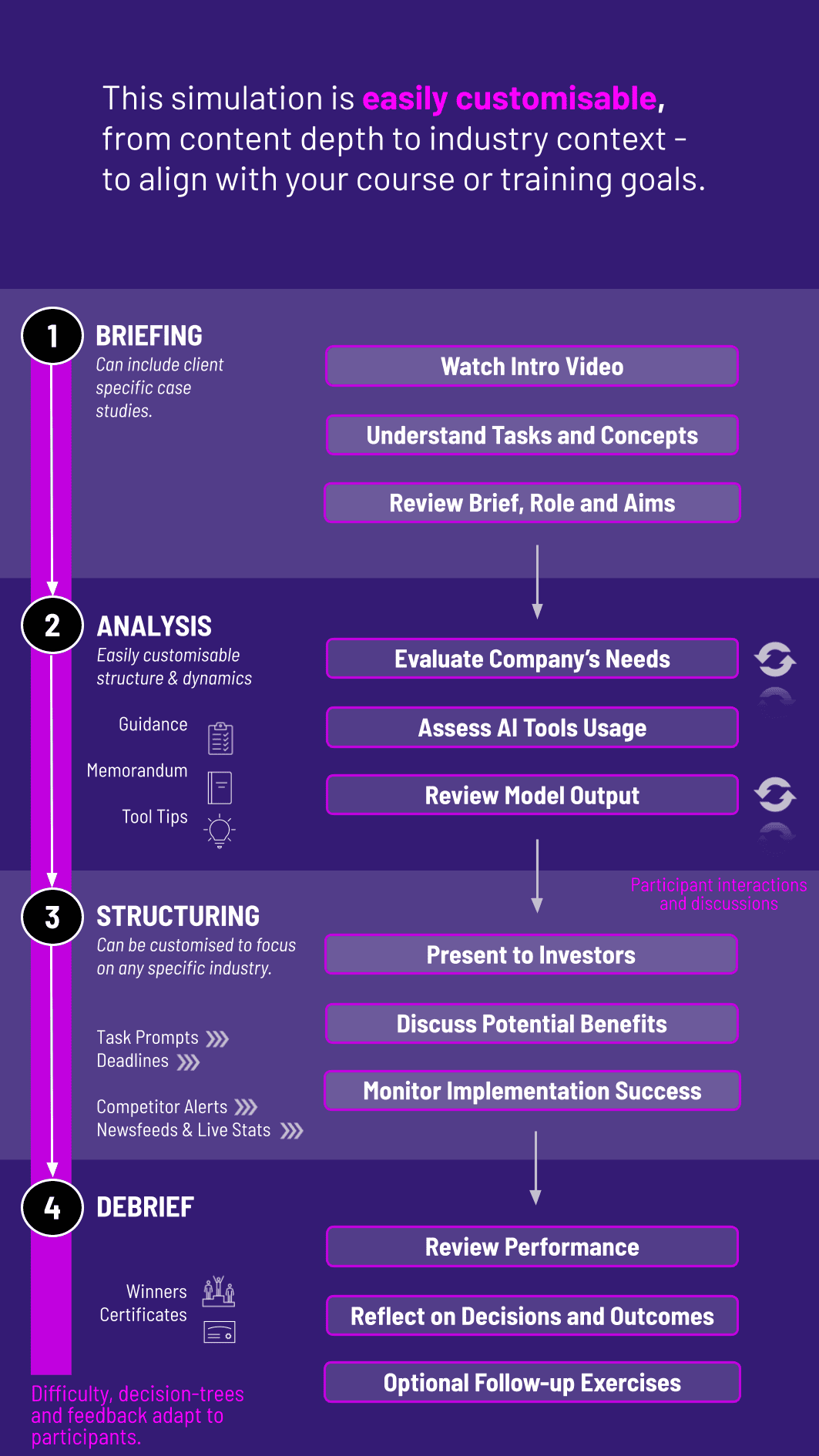
In this simulation, participants explore how artificial intelligence transforms investment, risk, and corporate finance decisions - balancing data-driven insights with human judgment, ethics, and organizational strategy under uncertainty.
AI applications in trading, credit, and corporate finance
Data-driven decision-making and predictive analytics
Algorithmic bias and ethical considerations
Regulatory challenges in AI adoption
Human-AI collaboration in financial contexts
Risk management with AI-based models
Transparency, interpretability, and trust in algorithms
Cost-benefit analysis of AI adoption
AI’s role in financial innovation and disruption
Limits of automation and importance of human oversight


Review AI model outputs for trading, lending, or investment decisions
Balance human judgment with machine recommendations
Manage risks from data bias, errors, or system failures
Respond to regulatory scrutiny or stakeholder concerns
Adapt strategies to external shocks such as volatility or market disruptions
Present AI-driven strategies to boards, regulators, or clients
By the end of the simulation, participants will be able to:
Apply AI concepts in financial decision-making
Recognize the strengths and weaknesses of AI models
Balance automation with human oversight in high-stakes contexts
Evaluate data quality and model transparency issues
Manage ethical and regulatory challenges of AI in finance
Respond to external shocks with agility
Communicate AI-based strategies persuasively to stakeholders
Collaborate across technical and business functions effectively
Anticipate long-term impacts of AI adoption in financial services
Build confidence in integrating AI into strategic finance decisions
The simulation’s flexible structure ensures that these objectives can be calibrated to match the depth, duration, and focus areas of each program, whether in higher education or corporate learning.
The simulation can be delivered individually or in teams, in classrooms, workshops, or executive education. Each cycle mirrors a decision-making round enhanced by AI inputs.
1. Receive a Scenario or Brief: Participants are introduced to a financial challenge where AI tools provide data-driven insights.
2. Analyse the Situation: They review model outputs, financial data, and contextual factors to weigh trade-offs.
3. Make Strategic Decisions: Participants decide whether to follow AI recommendations, override them, or adjust strategies.
4. Collaborate Across Roles: Teams represent different stakeholders - finance leaders, data scientists, regulators - debating risks and opportunities.
5. Communicate Outcomes: Participants deliver strategy memos, board updates, or client presentations explaining their choices.
6. Review and Reflect: Feedback highlights outcomes, AI effectiveness, and ethical implications. Participants refine their judgment in later rounds.
Do participants need technical AI skills? No. The simulation focuses on strategy and decision-making, not coding.
What types of AI are included? Applications like trading algorithms, credit scoring, and predictive models.
Can it be tailored for industries? Yes. Scenarios can reflect banking, investment, or corporate finance contexts.
Is bias in AI models included? Yes. Scenarios highlight fairness, ethics, and transparency issues.
Can teams take different roles? Yes. Teams may represent executives, data scientists, or regulators.
How long does the simulation run? It can be a 4-hour session or extended into a multi-day workshop.
Is it suitable for executives? Absolutely. It’s designed for both students and professionals in finance.
Does it cover regulation? Yes. Compliance and oversight are integral to the gameplay.
Can it run online? Yes. The simulation supports online, hybrid, and in-person delivery.
How is performance measured? By financial outcomes, ethical awareness, and communication effectiveness.
Quality of decisions balancing AI and human input
Recognition of risks and limitations in AI use
Clarity and persuasiveness of communication
Responsiveness to regulatory and stakeholder challenges
Collaboration across technical and strategic roles
You can also include memo writing and debrief presentations as part of the assessment structure. Additionally, you can also add a built-in peer and self-assessment tool to see how participants rate themselves. This flexibility allows the simulation to be easily integrated by professors as graded courses at universities and by HR at assessment centres at companies.
Join this 20-minute webinar, followed by a Q&A session, to immerse yourself in the simulation.
or
Book a 15-minute Zoom demo with one of our experts to explore how the simulation can benefit you.